
A few weeks ago I was once again out and about overlaying old postcards on the same modern-day views of Bordeaux. Among those pictures connecting the early 20th and 21st centuries was this one of the Jardin Public, and the card featured some lines from an “Ode à Bordeaux” written by one Lodoïs Lataste. Who was Lataste and what more do we know about his ode to the city?
 Lodoïs Lataste was born in Bordeaux in 1842 (and died in 1923) and various sources suggest that throughout his career he headed up a mutual benefit society in Bègles, was the deputy general secretary of the French mutualist press union, and – in Paris – was in charge of the drafting reports and laws passed by France’s lower parliamentary house (chef du service des procès-verbaux et de l'expédition des lois de la Chambre des députés). But Lataste was also a writer and composer, delivering, amongst many others, the lyrics to a work known as “Le rêve de l’orphelin” (1866), writing the words and music for a piece called “Fontainebleau !” in 1888, and also the patriotic work “Les deux sœurs”, celebrating the ties between France and Russia (1894).
Lodoïs Lataste was born in Bordeaux in 1842 (and died in 1923) and various sources suggest that throughout his career he headed up a mutual benefit society in Bègles, was the deputy general secretary of the French mutualist press union, and – in Paris – was in charge of the drafting reports and laws passed by France’s lower parliamentary house (chef du service des procès-verbaux et de l'expédition des lois de la Chambre des députés). But Lataste was also a writer and composer, delivering, amongst many others, the lyrics to a work known as “Le rêve de l’orphelin” (1866), writing the words and music for a piece called “Fontainebleau !” in 1888, and also the patriotic work “Les deux sœurs”, celebrating the ties between France and Russia (1894). Above all, Lodoïs Lataste is remembered for his 1904 “Hymne à la Mutualité”, an anthem that takes the form of a military marching tune. On the Musée de la Mutualité française website, the piece is described as “a piece of patriotic bravura in every sense of the word; General André, Minister of War, requested it be played in military parades and the anthem asserts itself as an educational act in favour of the reforming doctrine of mutuality”. Lataste earned a new nickname and became the "Rouget de l’Isle of mutuality", Rouget de l’Isle being the composer of France’s national anthem la Marseillaise.
While hunting down further information about Lataste’s anthem to mutuality, I came across a blog run by one JC Togrege, who had discovered an original score of the piece in among documents that had belonged to his parents. Togrege states that "In total, there are six couplets that include emblematic words such as freedom, proletarian classes, workers' pensions, social happiness, providence, etc." He also adds that "it is easy to poke fun at this largely bombastic style, but do not laugh at the values that are proclaimed. Remember that [France’s] Social Security system only dates back to 1945! Before that date, social protection was the domain of the mutualists, first and foremost through the mutual benefit societies that were the ancestors of today’s mutualist private insurance companies."

A musical score dating from 1905 as originally featured in a dedicated article on the Chroniques de JC Togrege blog (recommended reading!).
How about Lataste’s Ode to Bordeaux then? Obviously, the excerpt that features on my 1913 postcard praises the joys of the Jardin Public (the name of which rhymes in French with that of the Flemish Baroque artist Anthony van Dyck…):Un ravissant Eden où coule une rivièrePrès des lilas en fleurs, c'est le Jardin Public.On y voit des babys jouant sous l’ombrière,À tenter le pinceau d’un Greuze ou d’un Van Dyck.
(A lovely garden of Eden where a river flowsNear the lilacs in bloom, this is the Jardin Public.We see toddlers playing in the shadehouse,Scenes that could have been painted by Greuze or Van Dyck.)
Thanks to the wonders of the worldwide web, I have found two further postcards that also showcase Lataste’s written tribute to his home city. Here is what he had to say about the Tourny statue:

Source: mistercard.net
Ce joli monument consacre la MémoireD’un Maire de Bordeaux, l’Intendant de Tourny.
La splendeur de nos quais est entière à sa gloire,
Il sert toujours d’exemple aux Maires d’aujourd’hui.
(This pretty monument consecrates the memoryOf a Mayor of Bordeaux, the Intendant of Tourny.The splendor of our quays is entirely to his glory,It still serves as an example to today's mayors.)
And here is his homage to Gustave Eiffel’s now-disused iron railway bridge that spans the Garonne:
Salut beau Viaduc, jeté sur la Garonne
Imposant et léger ainsi qu'un arc-en-ciel !
Celui qui te conçut a parfait sa couronne
En créant à Paris la belle Tour Eiffel !
(Let us salute this fine viaduct that crosses the GaronneAs imposing yet as light as a rainbow!The person who conceived you perfected their crownBy creating the beautiful Eiffel Tower in Paris!)
So there we have three verses of Lataste’s poem to the glory of Bordeaux, but just how many verses and questionable rhymes were there in all? In ancient Greek literature, an ode was traditionally made up of seven verses, so if Lataste applied that rule what other four city sights did he immortalize in poetry? As I have yet to find the full text, that pleasing sense of mystery will remain… unless you can help me reconstruct, in its entirety, Lodoïs Lataste’s ode to Bordeaux. If you can, do get in touch!
Source material for this article found here:
> Musée de la Mutualité française
> Les chroniques de JC Togrege
> Bibliothèque nationale de France - BNF data
> « Liberté, égalité, mutualité: mutualisme et syndicalisme, 1852-1967 » (Michel Dreyfus)
> Cet article est également disponible en français !
